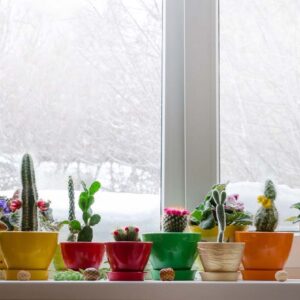By: Rachel Elmakiss
It is freezing outside! Temperatures are dropping, daylight is disappearing faster, and houseplants state-wide are not happy about it! Here are some tips to help keep your plants happy and thriving during their dormant season.
Houseplant care in winter
1. Lighting and Temperature
This time of year, your plants aren’t going to get quite as much light as they’re used to. While some plants can handle lower light, or short periods of low light, most will start to suffer without a sufficient light source (research your plants for their specific light requirements). To help supplement that light, you can use artificial lights! You can go out and purchase LED grow-lights, which do have a wider spectrum (great for plant growth), or for most plants putting them near a regular household LED bulb will do the trick short term.
Depending on your home, keeping them in the windowsill instead of scooting them back to avoid colder temperatures can help. This will, however, depend on your windows and on your home. Generally, keeping them close to the window for light is best, but moving them too close can cause them to get too cold.
Keep your home warm, BUT keep your plants away from heat sources and vents. Just as they’re sensitive to the cold, they’re also sensitive to hot, dry air.
2. Watering and Humidity
How often you water your plants in general depends entirely on the plant itself and what conditions it has in your home. In the winter, you usually want to cut back on your watering schedule, only watering when the top inches of the soil is dry. In some cases, people with warmer and dryer homes find themselves watering just as frequently, but people with higher humidity levels find themselves not watering their plants as frequently.
Winter is a very dry season, and most indoor plants prefer higher levels of humidity. You can always go buy a humidifier and place it near your plants, but there are a few other ways you can go about giving them more humidity. Bunching plants together will help increase humidity levels, as well as placing a pebble tray underneath and filling it to the top of the pebbles with water; as the water evaporates, it increases the humidity in the air. Keeping your plants in already-humid areas in your home, such as a bathroom or a kitchen, is also ideal for humidity loving houseplants.
3. Pests
Checking for pests in the winter is just as important as the rest of the year. Your plants may not be growing as fast, but pest populations can and will. Wiping the leaves of your houseplants with an insecticidal soap can help deter pests, as well as help the plant receive more light for photosynthesis. Mixing insecticide granules in the soil or putting diatomaceous earth on top of the soil can also help keep pests away during the winter. Make sure to regularly check your leaves for any signs of pests, especially the undersides.
These tips should help you keep your houseplants happy throughout the winter and serve as a good start to understanding your plants during the season. Each home and plant will be different, so make sure to take this tips and research your own plant to figure out what it needs. As always we at Cantrell Gardens are happy to help you answer any questions. Remember to check back once a month for more helpful blogs, and give us a call us today! with any questions or concerns!

